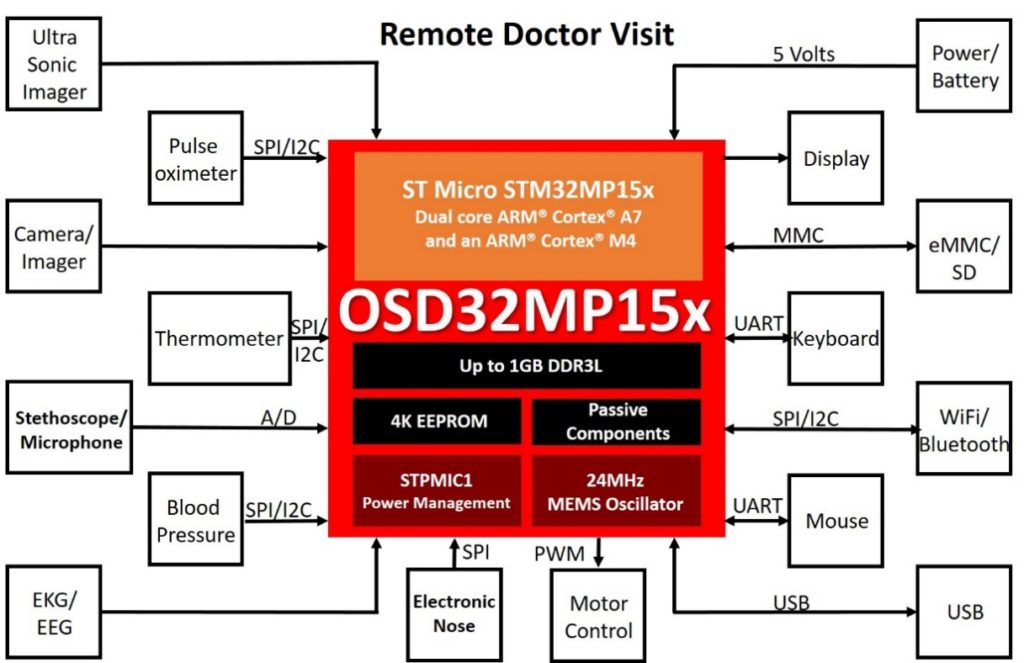Related Products
Virtual Doctor’s Visit with the STM32MP1 System-in-Package
Published On: January, 15, 2021 By: Gene Frantz | Updated: February 8, 2021 by Cathleen Wicks
We have come full circle in the world of the doctor’s visit. Before most of our lives, doctors made home visits. Then advances in transportation (automobiles) and communications (telephones) made it practical for patients (us) to visit the doctor in their office where the medical technology was available, eliminating the doctor’s rounds in a buggy. We are now at a point in the advancement of technology where it is again practical for patients to stay at home while the doctor makes home visits. That is, virtual visits. The virtual doctor’s visit is enabled by the audio, video, imaging and communications capability we now have, all under the control of embedded processors.
The Virtual Doctor’s Visit Terminal (VDVT) would allow the patient and doctor communicate visually, audibly and perhaps someday with others of the five senses (smell, taste and touch). As with any visit, vital signs could be taken. Images of the ears, nose and throat could be captured and audible sounds from the heart, lungs, etc. could be captured. Diagnostics of the sensor inputs could be done by the VDVT and quickly reviewed by the doctor. As seen in the block diagram in Figure 1, future capabilities could include Ultra-sonic images, EEGs, ECGs, to name a few.
At the center of the remote unit is an OSD32MP15x SiP. It contains the STMicroelectronics’ STM32MP15x featuring Dual Arm® Cortex® A7 Cores and an Arm® Cortex® M4, up to 1GB of DDR3L, STPMIC1 Power Management IC, EEPROM, MEMs Oscillator, and passives into a single easy to use BGA package. Ready for you to attach medical sensors, develop virtual human interfaces and attach the necessary actuators to make the remote doctor’s visit possible.
The Figure below shows a block diagram of the remote patient terminal that could enable a virtual doctor’s visit.
A PDF of this Application Note can be downloaded here.
The OSD32MP15x
Now for a quick preview of the OSD32MP15x. It not only has the capability to keep up with the performance and power efficiency demands of a virtual doctor’s visit terminal, but is also capable of handling future terminal improvements as you grow your number of product offerings:
Both a microprocessor and a microcontroller
Combining power efficiency and performance, the OSD32MP15x can read data from sensors, process the data and then securely communicate results to the doctor, and of course perform diagnostics on the acquired data. The combination of an ARM Cortex-A7 and a M4 processors is the optimal solution of processors for this application.
Dual core ARM™ Cortex™-A7 Processor
Can drive a high resolution audio and visual I/O (I.e., a quality GUI), process high level medical data from the sensors such as images and video from cameras, wirelessly transfer data to the cloud, and still have bandwidth to periodically communicate with the ARM Cortex-M4 microcontroller to coordinate the acquisition of the patient’s medical data.
ARM™ Cortex™-M4 microcontroller
Is a 209MHz RISC core that is designed to handle the acquisition and actuator aspects of the doctor’s visit efficiently: the sensing, actuator control and other tasks that require tight control or can be run at low power.
Energy Efficient
Even running at its full speed of 800MHz, the OSD32MP15x is designed to be power efficient device. With support for all low power modes, the power dissipation can be significantly reduced to support a wide range of applications while battery powered.
Security
Built with security at its core the OSD32MP1 supports TrustZone, Secure Boot and other security suites to ensure patients data is kept confidential.
Smallest Single Chip Computer Solution
The OSD32MP15x family offers single chip computer solutions that are over 60% smaller than a discrete implementation, making it ideal for unobtrusive remote devices of all shapes and sizes.
Linux open source libraries
Fully supported by mainline Linux and Yocto, leverage the Open-source Linux community to help speed up your development cycle.
Versatile GPIO interfaces
The OSD32MP15x supports multiple communication protocols/interfaces like UART, I2C, SPI, CAN, MMC, SDIO, USB, PWM, etc. to connect and control any peripheral needed to host a sensor, actuator, and communication device.
Faster Time to Market
The OSD32MP15x makes designing with a powerful Dual Core ARM Cortex-A7 processor as easy as working with a Microcontroller. You spend less time on getting the processor to work and more time on developing your product.
Get Started Today
Low Cost (OSD32MP1-BRK) and Full Featured (OSD32MP1-RED) Opensource development platforms are available for you to begin developing today
Learn More
Want to learn more? Contact us.
You can also sign up for our Mailing List to get the latest information on System-in-Package:
"*" indicates required fields

